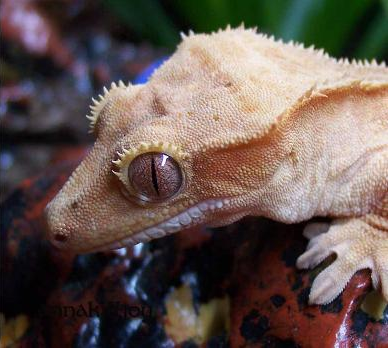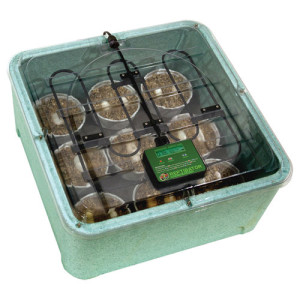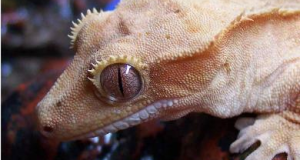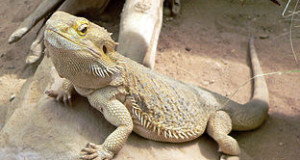In the past 20 or so years, the Crested Gecko (Correlophus/Rhacodactylus ciliatus), has gone from “presumed extinct” to being such a common pet that it may actually rival the Leopard Gecko in popularity! In addition to their interesting ways, innate “charm”, and extreme hardiness, these New Caledonian natives are also proving extremely easy to breed in captivity. Yet as I receive questions and review related articles and internet forums, it seems that some confusion exists on this topic. As Crested Geckos can provide a wonderful introduction to lizard breeding, today I’d like to review how best to get started. Also, since even un-mated females can produce eggs, and may suffer fatal impactions if not properly cared for when gravid, it is important for all owners to understand the basic principles of Crested Gecko reproduction.
Do I Have a Pair?
Crested Geckos show sexual dimorphism earlier than do many other lizards. By age 6 months or so, males will exhibit two easily-seen bulges near the cloaca, evidence of the internal male sex organs, or hemipenes. Small femoral and pre-anal pores may be visible even earlier. However, these may not be evident to folks who have not seen a good many mature males of this or related gecko species.
Unlike many lizards, Crested Gecko pairs may be housed together year-round. However, females that are not in breeding condition may be injured by males during unsuccessful copulation attempts. A bit of biting is normal at this time, but in small terrariums, or those lacking cover in the form of logs, plants, etc., injuries may occur.
Reproductive Age
Captive reptiles of many species often reach adult size faster than they might in the wild, but this does not always mean that breeding is possible or advisable.
Female Crested Geckos may become sexually mature by age 8 months or so, but it is best to forestall breeding until they are at least 1 – 1½ years old. Most successful long-term breeders use 40 grams as a safe weight for first-time breeding females. Males may be bred at the same or a slightly younger age, and are generally a bit lighter in weight than females.
Stimulating Reproduction
There doesn’t seem to be much in the way of detailed field studies of Crested Gecko reproduction. Judging from the temperature profile of their habitat, they most likely breed throughout New Caledonia’s warm season (November to April), when temperatures average 74-85 F.
Pets kept in temperate regions are usually stimulated to breed by local seasonal changes, beginning as the weather warms in spring and ceasing in autumn. In tropical and semi-tropical regions, well-fed females may continue to deposit eggs throughout the year. This can deplete calcium stores and otherwise impact long-term health. Cooling geckos to 68 F by day and 65 F by night, and reducing the daytime period to 10 hours, has been useful in stopping reproduction (however, this must be done gradually…please post below if you need further information).
Egg Deposition
Female Crested Geckos deposit clutches of 2 eggs. They usually produce multiple clutches, separated by approximately 30 days (but this number varies widely), each breeding season. Three to 5 clutches are generally considered as being typical for well-fed pets, but up to 10 have been reported.
In naturalistic terrariums, eggs may be secreted beneath the substrate at the base of plants, cork bark, or other cover. Gravid females are sometimes seen digging in several spots before deciding on a nest site.
Even if nesting sites are available in the terrarium, boxes or caves provisioned with a mix of moist sphagnum moss and soil should always be provided. This will simplify egg retrieval (if they are used, of course!) and will assure that there will always be a suitable nest site. Female geckos that cannot find a site to their liking may retain their eggs, which will eventually lead to a fatal infection (egg peritonitis).
Also, bear in mind that female Crested Geckos are able to store sperm. Those purchased as adults, or separated from a male, may still produce fertile eggs. As mentioned above, females that have not mated may also develop eggs, which must be deposited.
Stay alert for signs that a female may be egg-bound – lethargy, swollen abdomen, straining – and see a veterinarian if this occurs.
Crested Gecko eggs have been successfully incubated under a wide range of conditions. Here again they vary from many reptiles, as the eggs are extremely resilient and develop well at unusually-low (by lizard standards) temperatures.
As with most eggs, I favor course vermiculite or pearlite as an incubation medium. A water: substrate mix of 1:1 by weight works well. The eggs may be incubated in an room with an appropriate temperature range, or a commercial reptile egg incubator. Please see the article linked below for information on a simple method of calculating and tracking water content.
I haven’t found anything definitive concerning the effect of incubation temperatures on hatchling sex, but several anecdotal notes report that females predominate at temperatures of 77-80 F, males at 82 F, and mixed sexes at 70-76 F (the range most favored by experienced breeders). Incubation temperatures exceeding 84 F are said to kill the embryos.
Incubation periods range from 65-120 days, depending upon temperature and, in all likelihood, humidity levels and other factors.
Please post below for information on rearing young Crested Geckos.
Further Reading
 That Reptile Blog – Reptile, Amphibian and Exotic Pet Care and Information
That Reptile Blog – Reptile, Amphibian and Exotic Pet Care and Information








